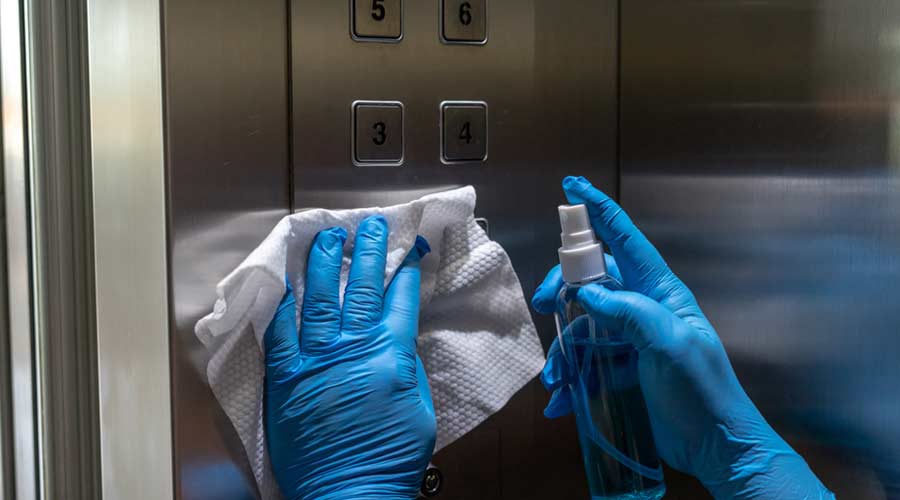
The cleaning industry is undergoing a significant transformation, shaped by evolving customer expectations, advancements in technology, and an increasing emphasis on sustainability and health standards. As businesses and institutions strive to maintain safer, cleaner environments, the demand for innovative solutions and skilled labor continues to rise. At the same time, the industry faces persistent challenges, including workforce shortages, regulatory changes, and the need to balance efficiency with environmental responsibility.
This roundtable brings together leaders, innovators, and experts from across the cleaning sector to explore current trends and share insights on overcoming these challenges. From the integration of smart cleaning technologies and eco-friendly products to strategies for talent retention and operational excellence, this discussion aims to uncover practical approaches and forward-looking strategies that are shaping the future of the cleaning industry.

Tony Almeida
Manager, Custodial Services, Maintenance & Operations
Elk Grove Unified School District

Ada Baldwin, M.R.E.H.
Director for University Housekeeping
North Carolina State University

Sharon Boyd
Supervisor of Custodial Services
Newport News Public Schools

David Crowell
Director of Facilities
Maine Veterans’ Homes

Jodi Krause
Assistant Director – Building Services
University of Wisconsin-Madison

Ricky Martinez
Assistant Director of Facility Services
Salt Lake City School District

April Walton
Custodial Services Manager
Wisconsin State Fair Park
The cleaning industry is known for its high turnover rate, but that doesn't seem to be an issue with in-house departments. What's the labor situation in your department and why do you think in-house teams are able to hold onto staff better than contractors?
WALTON: We are not exempt from high turnover rates, but this is largely due to our rule regarding limited term employment (LTE) under the current (Wisconsin) state statue for LTEs. This makes our labor fairly transient in some respects. Contractors tend to enter into business with us under strict guidelines that must be adhered to via a rigorous bidding process. Contractors go where the bid goes so in that way this employment may be less stable than an in-house team with ties to the company.
CROWELL: In house departments, in my experience, are better at retaining a more integrated staff who perform better than outsourced staff.
KRAUSE: Our program is an in-house cleaning staff. We retain our staff through wages and benefits along with other perks including education support. We have very few vacancies currently in our cleaning team and are seeing more vacancies in our maintenance and trades areas. Difficulties for those vacancies is finding qualified employees for the wages we currently offer.
MARTINEZ: Job Stability and Benefits: In-house staff are usually employed directly by the institution (e.g., schools, hospitals, or corporations), which often means better job security, access to benefits like health insurance, paid leave, and retirement plans — perks that many contractors don't provide consistently.
Sense of Belonging and Recognition: In-house employees are part of the broader organization, which can foster a sense of community and loyalty. They’re more likely to be recognized and appreciated by other staff, which contributes to job satisfaction.
Consistent Schedules and Workloads: In-house teams often enjoy more predictable work hours and stable workloads. Contractors, on the other hand, may face fluctuating schedules or be moved between job sites with little notice.
Opportunities for Advancement: Many institutions provide training and promote from within, giving in-house employees a career path that can be motivating and reduce turnover.
Better Working Conditions: Because institutions are directly responsible for their employees, there is often more accountability around safety, proper equipment, and respectful treatment—areas where contracted workforces can sometimes fall short.
BOYD: I have had the opportunity to manage in-house and contractor custodial employees. I found that in-house has a lower turnover rate. Some factors that have a direct impact in the higher turnover rate with contracted custodial workers are (1) feeling as if they are not part of the business/culture, (2) less benefits such as retirement, PTO, and health insurance coverage, and (3) no room for growth or promotions. My current position as Supervisor of Custodial Services for a large local school system averages a 7 percent turnover rate.
ALMEIDA: In my experience, in-house cleaning staff tends to be more stable than in contracted services for these reasons:
1. Better Pay and Benefits — In-house staff are often classified as employees of the organization (such as a hospital, school, or corporate office), which typically comes with better compensation packages. This can include health insurance, retirement plans, paid time off, and job security. Meanwhile, contract cleaning companies may operate on tighter margins and often provide fewer benefits.
2. Stronger Sense of Belonging (family) — In-house workers are part of the broader organizational culture. They often feel more connected to the mission, people and students of the organization, which can boost morale and engagement. Contractors may feel like outsiders, which can contribute to a lack of motivation and higher turnover.
3. More Predictable Schedules — In-house teams usually have more consistent scheduling, leading to better work/life balance. Contract employees sometimes face variable shifts, last-minute changes, or irregular hours, which can create burnout and dissatisfaction.
4. Investment in Training and Development — Organizations that maintain in-house teams are more likely to invest in ongoing training, performance feedback, and professional development — factors that help employees grow and stay longer. Contractors might not receive the same level of investment.
5. Union Representation — Many in-house departments are unionized, giving workers a collective voice, formal grievance procedures, and a greater sense of stability. Contractors are less likely to be unionized.
What are the three biggest challenges in hiring and retaining janitorial staff today?
ALMEIDA: High turnover and low job satisfaction are several challenges. Custodial positions often face high turnover rates due to the nature of the work — physically demanding, repetitive, and sometimes lacking appreciation. Many employees view it as a temporary or transitional job, making long-term retention difficult. Lack of career advancement opportunities and minimal recognition contribute to overall dissatisfaction.
Labor shortages and competition for low-wage labor is a huge challenge across industries (e.g., warehouse, retail, food service), especially since the COVID-19 pandemic, which reshaped all workforce expectations. Custodial work often loses candidates to jobs that offer better pay, benefits, or working conditions. Background checks and schedule requirements can also limit the hiring pool as the onboarding could take months. Lastly, rising minimum wages and employee expectations for benefits (like healthcare, paid time off, and flexible schedules) are pushing employers to improve compensation packages. Many janitorial companies operate on thin margins, especially if they rely on fixed contracts, making it challenging to offer competitive pay. Without competitive offerings, both hiring and retaining workers becomes more difficult.
BOYD: Knowledge — There is an overall lack of knowledge about the cleaning industry's best practices. Skills — Coming on board with little-to-no cleaning skills or the inability to learn effectively. Ability — This seems to be a new concern in all service-oriented positions. Persons coming onboard appear to lack a sense of overall ability or desire to perform well, or provide service to others.
CROWELL: Keeping them engaged during the onboarding process, making sure they are integrated properly with the entire organization, and checking in regularly with them.
KRAUSE: The first challenge is providing competitive wages compared to similar markets (such as city or county jobs). Challenge two is the retention of qualified staff. We offer a number of perks other than benefits in order to improve the retention of our team members. The final challenge is communication and management of staff. We have staff that speak several languages and a wide range of generations within our team. We must make sure that we are providing the support and resources they need in order to retain them.
MARTINEZ: High Turnover and Labor Shortages: Custodial roles often experience high turnover due to the physically demanding nature of the work and relatively low wages. Many employers struggle to find and keep reliable workers, especially in a tight labor market.
Wage Competition and Inflation: As wages rise in other low-skill sectors like retail and food service, custodial positions must compete by offering more attractive pay and benefits. Budget constraints, especially in public institutions or fixed-contract environments, often make it hard to match these increases.
Generational Employees: The new generation (millennials) are a challenge to retain because you have to figure out what inspires and motivates them. The challenge is figuring out what that is and being consistent. This is not a one size fits all approach. You have to adapt to different personalities and team diversity.
WALTON: Job growth, stagnant wages, and an aging population. Not many people are vying for the spot on the custodial staff. It is no longer a viable blue collar job option. It is not attractive to younger generations.
What retention/upskilling strategies do you have in place for your team and why do you think they are successful?
BALDWIN: We are rolling out a career progression plan for retention and upskilling our team. There will be three phases focusing on entry-level, mid-level and then advanced-level positions. The goal for success is to advance competencies and skills that will ensure staff are confident and prepared when opportunities for advancement arise. For example, developing a workforce with higher skill and competency levels in order to increase performance efficiencies. Also compensating staff based on demonstrated competencies and skills.
WALTON: I am working through a comp plan where the staff can upskill and for each skill they learn, they can be compensated for it depending on competency. This gives you something to look forward to when lead and supervisory postings may be few and far between.
CROWELL: See my response above — not doing those things will keep staff engaged and learning how integrated their role is.
KRAUSE: Educational support — This can be reimbursement for college courses that staff members complete, as well as classes offered on our campus for our staff to learn English for better communication and personal growth. Free or low-cost personal and professional classes. We offer a huge variety of free or low-cost training and seminars on campus. This includes CPR, financial classes, career-based classes such as leadership and management. We also offer food discounts in our Dining Halls for staff. We offer innovation and initiative awards (monetary) and merit raises.
MARTINEZ: The Salt Lake City School District has established an annual Employee Appreciation Day, held each June, to recognize and celebrate the hard work and dedication of our staff. On this day, employees gather at a designated school site to participate in collaborative team-building activities. Lunch is provided, and staff are given the remainder of the day off with pay. This event has been met with overwhelmingly positive feedback, with many employees especially valuing the opportunity to engage in team-building experiences.
In addition, the District has introduced a Professional Development Day, held annually in March or April. This event features workshops and training sessions led by external vendors, industry experts, and members of our Human Resources team. Topics include skill development, workplace safety, leadership, and career advancement. This initiative reflects our ongoing commitment to supporting our employees' professional growth and well-being by providing them with the tools and resources necessary to enhance both their professional and personal lives.
BOYD: We continuously keep candidates in the pipeline using more frequent interviews or job fairs. We also have incentives such as trivia Tuesday, employee of the month, and staff lunches. Finally, we publish “Custodial Dispatch,” a monthly newsletter for the department with a goal to improve communication.
ALMEIDA: We encourage continuous learning through a mix of internal training, external certifications, and access to online learning platforms like LinkedIn Learning or Coursera. We also run lunch-and-learns and peer knowledge-sharing sessions to make learning collaborative.
Mentorship, cross-training, and job shadowing have also helped. Team members are paired with mentors inside the team for career development. Cross-training across functions not only deepens skills but also promotes empathy and collaboration across various roles.
We also actively recognize achievements, both big and small, and ensure that career path growth is transparent with our employees. This helps people see a future with the organization and understand what is required to reach the next level in their career.
Product Trends Impacting Cleaning Departments

 The Down and Dirty on Cleaning in Virus Season
The Down and Dirty on Cleaning in Virus Season How Surfactant Use is Expanding in Commercial Cleaning
How Surfactant Use is Expanding in Commercial Cleaning